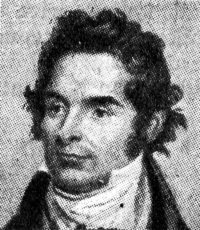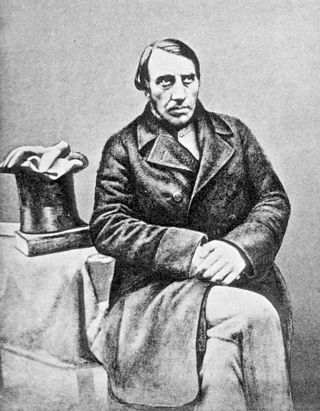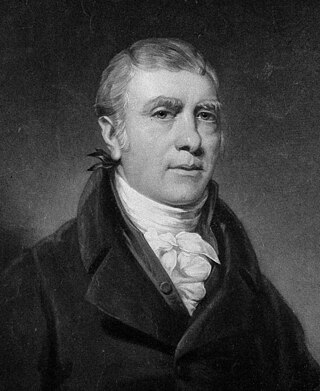Related Research Articles

The Dean Cemetery is a historically important Victorian cemetery north of the Dean Village, west of Edinburgh city centre, in Scotland. It lies between Queensferry Road and the Water of Leith, bounded on its east side by Dean Path and on its west by the Dean Gallery. A 20th-century extension lies detached from the main cemetery to the north of Ravelston Terrace. The main cemetery is accessible through the main gate on its east side, through a "grace and favour" access door from the grounds of Dean Gallery and from Ravelston Terrace. The modern extension is only accessible at the junction of Dean Path and Queensferry Road.

William Scoresby was an English whaler, Arctic explorer, scientist and clergyman.

Robert Jameson FRS FRSE was a Scottish naturalist and mineralogist.

William Roxburgh FRSE FRCPE FLS was a Scottish surgeon and botanist who worked extensively in India, describing species and working on economic botany. He is known as the founding father of Indian botany. He published numerous works on Indian botany, illustrated by careful drawings made by Indian artists and accompanied by taxonomic descriptions of many plant species. Apart from the numerous species that he named, many species were named in his honour by his collaborators.

Alexander Monro III of Craiglockhart, FRSE FRCPE FSA (Scot) MWS, was a Scottish anatomist and medical educator at the University of Edinburgh Medical School. According to his detractors, Monro was an uninspired anatomist who did not compare with his brilliant father or grandfather as a teacher or scientist. His students included Charles Darwin who asserted that Monro "made his lectures on human anatomy as dull as he was himself."

John Fleming FRSE FRS FSA was a Scottish Free Church minister, naturalist, zoologist and geologist. He named and described a number of species of molluscs. During his life he tried to reconcile theology with science.

John Goodsir was a Scottish anatomist and a pioneer in the formulation of cell theory.

Thomas Thomson MD was a Scottish chemist and mineralogist whose writings contributed to the early spread of Dalton's atomic theory. His scientific accomplishments include the invention of the saccharometer and he gave silicon its current name. He served as president of the Philosophical Society of Glasgow.

William Wright (1735–1819) was a Scottish physician, botanist and slave owner. In 1783 he was a joint founder of the Royal Society of Edinburgh.
The Wernerian Natural History Society, commonly abbreviated as the Wernerian Society, was a learned society interested in the broad field of natural history, and saw papers presented on various topics such as mineralogy, plants, insects, and scholarly expeditions. The Society was an offshoot of the Royal Society of Edinburgh, and from its beginnings it was a rather elite organization.

The Munros of Auchinbowie are a distinguished branch of the Scottish, highland Clan Munro. From this family three Professors of Anatomy at the University of Edinburgh, Scotland were produced, as well as several other doctors and military officers.
John Fleming was a British surgeon of the Indian Medical Service, naturalist, and politician. While in India he served as an interim superintendent of the Royal Botanic Garden, Calcutta before William Roxburgh took charge. He was the Member of Parliament (MP) for Gatton 1818–1820, Saltash 1820–1826. Fleming was an amateur botanist and a Fellow of the Royal Society of London, Royal Society of Edinburgh and the Linnean Society.

John Barclay was a Scottish comparative anatomist, extramural teacher in anatomy, and director of the Highland Society of Scotland.

Andrew Duncan, the elder FRSE FRCPE FSA (Scot) was a British physician and professor at the University of Edinburgh. He was joint founder of the Royal Society of Edinburgh. As first proposer of an asylum in Edinburgh he gives his name to the Andrew Duncan Clinic which forms part of the Edinburgh City Hospital.

Patrick Neill was a British printer and horticulturalist, known as a naturalist. A founding member, and the first secretary, of both the Wernerian Natural History Society (1808–49) and the Caledonian Horticultural Society (1809–49), he is mainly remembered today for having endowed the Neill Medal of the Royal Society of Edinburgh.

Henry Dewar of Lassodie MD FRSE (1771–1823), originally Henry Frazer or Fraser, was a Scottish minister turned physician, known as a writer.

Henry Stephens FRSE was a 19th-century Scottish farmer, meteorologist and agricultural author. His multi-volume Book of the Farm was a standard text for some seventy years after its first edition of 1844.
John Hennen FRSE was an Irish-born military surgeon and author of the acclaimed medical textbook The Principles of Military Surgery.

John Thomson FRS FRSE PRCPE (1765–1846) was a Scottish surgeon and physician, reputed in his time "the most learned physician in Scotland". He was President of the Royal College of Physicians of Edinburgh from 1834 to 1836.

John Lindsay Stewart was a 19th-century Scottish botanist remembered for his conservation of Indian forests.
References
- ↑ A Sailor in the Sahara, J. B. Lockhart
- ↑ Edinburgh Post Office Directory 1818
- ↑ Memoirs of the Wernerian Natural History Society, vol 3, p.539
- ↑ Biographical Index of Former Fellows of the Royal Society of Edinburgh 1783–2002 (PDF). The Royal Society of Edinburgh. July 2006. ISBN 0-902-198-84-X. Archived from the original (PDF) on 4 March 2016. Retrieved 4 June 2018.
- ↑ Edinburgh Post Office Directory 1820
- ↑ The Edinburgh Annual Register 1821
- ↑ British Medical Journal 1857
- ↑ Edinburgh Medical and Surgical Journal vol 15